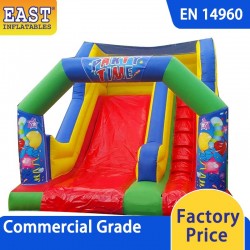
Introduction:
Inflatable slides have gained immense popularity as a thrilling and engaging source of entertainment for children and even adults. These whimsical structures can be found at various events, parties, amusement parks, and even in backyards. However, like any equipment, inflatable slides have a finite lifespan that is influenced by several factors. In this article, we'll explore the typical usage cycle and lifespan of an inflatable slide.
Quality of Materials:
The lifespan of an inflatable slide is greatly determined by the quality of materials used in its construction. High-quality, durable materials can withstand prolonged usage and exposure to the elements. Factors such as the thickness of the PVC material, quality of stitching, and reinforcement in high-stress areas play a crucial role in determining how long the slide can last.
Frequency of Usage:
The frequency of usage significantly impacts the lifespan of an inflatable slide. A slide that is set up occasionally for special events may last longer than one that is used daily. Continuous and frequent usage puts stress on the materials, causing wear and tear over time. Thus, a well-maintained slide that experiences intermittent use may have a longer lifespan compared to a heavily used one.
Proper Installation and Deflation:
Proper installation and deflation are essential for preserving the longevity of an inflatable slide. Careful setup, following manufacturer guidelines, prevents unnecessary strain on the material and seams. Equally important is the correct deflation process, which prevents overstretching and damage during storage.
Maintenance and Cleaning:
Regular maintenance and cleaning routines contribute to prolonging the lifespan of an inflatable slide. Regularly inspecting the slide for any signs of wear, tears, or loose stitching and addressing these issues promptly can prevent minor problems from escalating. Cleaning the slide to remove dirt, debris, and moisture also prevents material degradation.
Environmental Factors:
Environmental conditions play a role in determining the lifespan of an inflatable slide. Extended exposure to sunlight can cause the material to fade and weaken over time. Additionally, harsh weather conditions like rain, wind, and extreme temperatures can contribute to material deterioration.
Storage:
Proper storage during periods of non-use is crucial. Storing the slide in a dry, cool place away from direct sunlight and extreme temperatures prevents unnecessary damage. Folding and storing the slide according to manufacturer recommendations help maintain its shape and structure.
Conclusion:
Inflatable slides offer hours of joy and entertainment, but their lifespan is influenced by various factors. The quality of materials, frequency of usage, proper installation and deflation, maintenance and cleaning routines, environmental conditions, and storage practices all contribute to how long an inflatable slide can last. By following best practices and caring for the slide diligently, its usability can be extended, allowing for more memorable moments and fun-filled adventures.




Leave a Comment